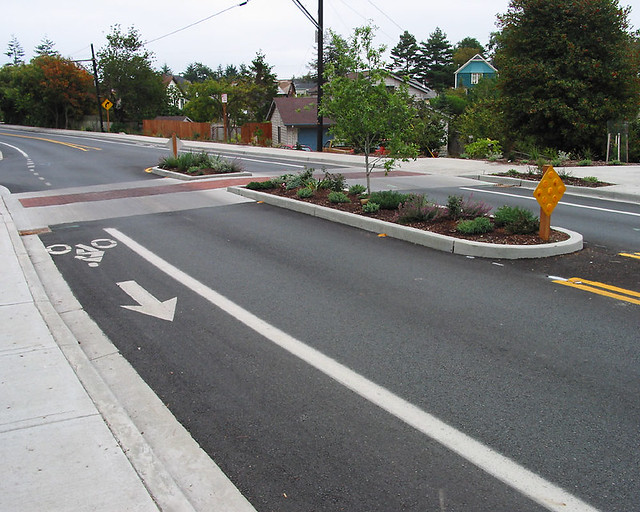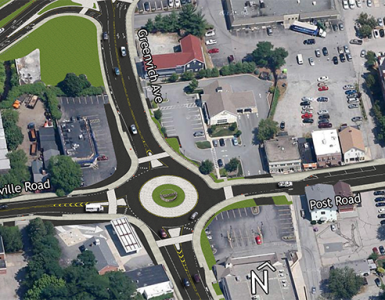Public bus navigating roundabout in Washington State | Photo by Washington State Dept of Transportation from Flickr
The Project for Public Spaces has a post on their blog today about modern roundabouts. Being from Cape Cod, the home of the rotaries from hell, I’ve been slow to come around to the idea of roundabouts (which are actually different from rotaries). I’ve spent too many hours of my life on the Airport Rotary in Hyannis or the Mashpee Rotary (or every other rotary on the Cape) yelling at the tourist from maude knows where who keeps stopping on the rotary. The rotaries we see on the Cape and some other areas are however a different beast from the modern roundabout. Rotaries are basically big highways set in a circle designed to quickly spin traffic around and shoot it out in different directions, roundabouts are much smaller and designed to make traffic flow smoothly, but actually have the idea of slowing traffic at their core.
PPS cites the Washington State Department of Transportation about the safety benefits of roundabouts versus signalized intersections:
1) Low travel speeds – because drivers must yield to traffic before entering a roundabout, they naturally slow down, 2) no red lights to run – roundabouts are designed to keep traffic flowing without requiring vehicles to stop, so the incentive for drivers to speed up to make it through a yellow or red light is removed, and 3) less potential for serious crashes – since vehicles all travel around the center island in the same direction, head-on and left-hand turn (T-bone) collisions are eliminated.
One concern I have about roundabouts is how they work for pedestrians. Below is a video from the Mayor of Carmel, Indiana explaining the benefits of roundabouts in his community. He has some comments on the benefits to pedestrians.
In the video, the Carmel Mayor cites the reduced traffic speed as a safety feature for pedestrians. I suppose if I were to be hit by a car, I’d prefer to be hit by one slowing to navigate a roundabout rather than one speeding to make it through a yellow light. I think I’d prefer to just not be hit though. Looking at the geometry of a roundabout, I’m concerned about crossing the roundabout exit. How is a pedestrian to judge if a vehicle is staying in the roundabout or exiting to where she is trying to cross? Ideally the vehicles exiting would signal such (that is what you are supposed to do on a rotary so traffic entering can know you are leaving), but this is Rhode Island, we may need an 8 week course to show drivers where their turn signals are.
The Carmel roundabouts have a recessed crosswalk (i.e. set back from the actual intersection) with a center median serving as a pedestrian refuge. This arrangement does not address slowing traffic exiting the roundabout to allow for pedestrian movement. One tool that could be used to slow traffic exiting the roundabout is the use of raised crosswalks.
Raised crosswalk with median pedestrian refuge | Photo by Richard Drdul from Flickr
Most of us are aware of the giant mountain on Smith Street at the State House, this is a somewhat extreme example of a raised crosswalk. At the other end of the scale, we have some raised crosswalks in Kennedy Plaza that barely even register with drivers. A raised crosswalk should force drivers to slow somewhat, but not force them to come to a complete stop if there are no pedestrians in the crosswalk.
Another concern for roundabouts is how bicycles would navigate them. Traffic slows enough to navigate a roundabout that it comes down to bicycle speeds, allowing bicycles to move into traffic and use the roundabout just as a car would. This video from the New York State Department of Transportation shows this:
While most roundabouts in the US are being built in suburban areas, in Europe roundabouts are used in urban areas like Providence. Do you think roundabouts are a traffic measure that should be explored for Providence? Where would you propose roundabouts should be installed here?






They are starting the construction in Apponaug in Warwick which will consist of several roundabouts. Looks like a pretty good plan, to me. One of the few intersections which get backed up at red lights would be Memorial Blvd. at the mall, trying to get on the highways. Not sure how effective a roundabout would be there.
I wonder if its too late to have RIDOT seriously re-examine the plan they’ve proposed for Benefit/Wickenden/S. Main/S. Water/Point Street to see if a design that included this could address resident concerns about speeds of vehicles leaving the highway, access to Benefit, access to the 195East and pedestrian and bicycle friendliness.
Ok here’s where I’d like to see them:
1) The intersection of Dean St. and Broadway
2) The intersection of Empire and Sabin and or Fountain
3) That monster intersection by the ProJo building where Fountain, Sabin, Dorrance and Francis all meet.
I agree with Alex, that I-95 onramp near the mall would benefit from a roundabout too. The problem is now that they’ve shut down other ramps to I-95, that’s the only ‘local’ one for me.
I’d like to see a bike lane on that roundabout. Or anywhere in the city where people actually ride their bikes all the time because that’s how they transport themselves, not simply because it is a monied area where people cycle for recreation purposes.
I wonder how roundabouts perform where there are lots of pedestrians like Tony P’s #2 or #3 or the mall. I guess that as long as pedestrians do not stop vehicles in the circle itself, every pause at one point allows better flow elsewhere, so things balance out and keep moving.
Could be good at North Main and Doyle.
I do not see how a bike lane can work in a roundabout – it is all about criss-crossing and weaving. Low speeds and orderly yielding make it safe for cycles. If it is still too nerve wracking, become a pedestrian. That will still take less time than waiting through a long red light.
That said, Emily is entirely right that it is high time for bike lanes where cyclists actually need them most, not just where they can be created cheaply and with zero impact on car space.
From http://en.wikipedia.org/wiki/Roundabout#Safety:
“The most common roundabout crash type for cyclists involves a motor vehicle entering the roundabout and colliding with a cyclist who already is traveling around the roundabout…
The next most common crash type involves motorists leaving the roundabout, colliding with cyclists who are continuing farther around the roundabout carriageway…
If the adjacent cross-walks are not properly designed, there are increased risks for persons with visual impairments. This is because, unlike traffic signals, it is hard to hear if there is an adequate gap in traffic to cross. During the all-red interval at a signal, traffic comes to a stop, and blind pedestrians can tell by listening which direction gets the green light. Since there is often moving traffic at a roundabout, the sounds of non-conflicting traffic will mask gaps, or the sound of an idling vehicle whose driver has yielded to the pedestrian.”
From this it seems that they are good for vehicular traffic, but little else.